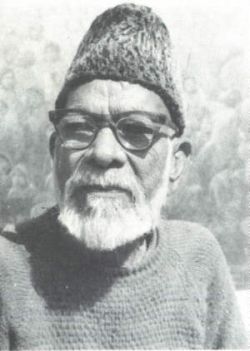

|
|
||
|
Master strokes of Ustad Allah Baksh |
||
 Whenever our folk culture
and life will be talked about, the name of Ustad (ustad means a maestro) Allah Baksh will stand
out prominently. He was the man who immortalized our rural life, and
specially of the Punjab – the land where he was born in 1885 in the
small town of Wazirabad. His very near-to-life life-size paintings are
full of colour, life and people that forces an onlooker to stop in his
tracks and appreciate his masterly work of art. Whenever our folk culture
and life will be talked about, the name of Ustad (ustad means a maestro) Allah Baksh will stand
out prominently. He was the man who immortalized our rural life, and
specially of the Punjab – the land where he was born in 1885 in the
small town of Wazirabad. His very near-to-life life-size paintings are
full of colour, life and people that forces an onlooker to stop in his
tracks and appreciate his masterly work of art.
Ustad Allah Baksh was lucky to have found Master Abdullah, a great maestro of his own time and a master of miniature art. He started learning from his ustad at the age of five and by the age of fourteen he had become an artist of his own style. He also learnt the art of painting from Master Meeran Bakhsh Naqash, a known teacher and painter and was also the Vice Principal of the Mayo School of Arts, now the National College of Arts Lahore. He started his career at the young age as signboard painter, and then found his way to railway’s workshop in Moghalpura Lahore as carriage painter. For some time, he also worked for Agha Husher’s theatrical company, painting background screens. By 1919, he had become a fine art painter and took on the profession as a commercial artist.
He also painted characters of Hindu mythology and also participated in art exhibitions at Bombay and Calcutta. His work being unique and rich in heritage won him many a accolade and laurels. Maharaja of Patiala, impressed by his work, invited him to his palace in 1937 to paint exclusively for him. Allah Baksh stayed there till the partition of the British India, after which he came back to Lahore and stayed here for the rest of his life painting the beautiful landscape of Punjab, its people and village life that ran into his veins since childhood.
Ustad Allah Baksh’s artwork is rich and expressive. His paintings show lot of people and when seen closely, each face gives a different expression, mood and style. All along he had his own distinctive and unique romantic style from which he never transgressed nor anyone else could imitate or replicate. His masterpieces include Sohni Mahiwal, Heer Ranjha, Sohni Dharti, Talism-e-Hosh Ruba, besides painting many festivities and rural scenes of Punjab.
Although his basic theme revolved around his own cultural heritage, he is also said to have been inspired by the classical western paintings, which may be attributed to his extensive movement to Bombay and Calcutta where the British artwork had influenced the local artists.
Ustad Allah Baksh’s specialty was in oil painting and that too on large canvases. But being an Ustad, he had mastery over other forms of painting and sketching mediums like the water colours, tempera colours, pencil work and even pen and ink. He could even combine different mediums suiting to his aesthetic nature and innovative mind.
Like good masters and ustads, Allah Baksh did not keep his art to himself; rather he gave art training to students for free. The great Ustad breathed his last on 18th October 1978 at Lahore. His art treasure has been preserved in the National art gallery is an exclusive corner attributed to one of the great master painters of Pakistan and Indo-Pak subcontinent.
Besides, his studio where he used to spent most of his time, has been converted into an academy "Allah Bux Academy" which is now serving as a learning ground for those who wants to excel in this great master's style.
In 1979, while celebrating the 15th anniversary of the RCD (Regional Cooperation for Development, later re-named as ECO) one of Ustad Allah Bakhsh’s painting, titled Village Scene, was selected to appear on the art of Pakistan. For his great artwork and services in the field of art projecting the indigenous folk heritage, he was awarded the prestigious Presidents medal for Pride of Performance. Pakistan Post also acknowledged Ustad Allah Bakhsh while printing a set of stamps to honour the great painters of Pakistan on December 24, 1991.
The great and unique artwork of Ustad Allah Bakhsh is our national heritage and his name shall always be remembered for the great service he did to paint and preserve our cultural heritage. |
|
| HOME PAGE | MORE ABOUT GREAT PAINTERS | Copyright © JalalsPages - 2005 - 2013 |